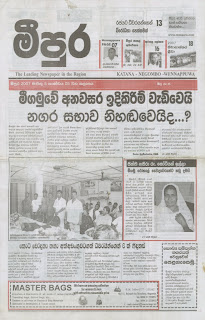“A Cocktail in English” is a very interesting book written by Dr. Navamany Selvarajah. I met her when I went to Jaffna during the ‘happy hour’ when the Ranil Wickremasinghe government signed a peace accord with the LTTE, and we would travel along the A9 to Jaffna for the first time in many years.
Dr. Selvarajah’s book was published in Jaffna in 2005 and she sent me a copy to be reviewed. I’m going to try and get a new edition published in Colombo, but the first edition with all its typos and little foibles is a gem.
The author, who now lives in retirement in Jaffna, is a professor of zoology and former head of the Department of Zoology in the University of Jaffna. She has a B.Sc (Hons) from Sri Lanka and a M.Sc (Research) from Britain. Her book, however, is hardly academic, and that’s why I find it so interesting.
As Dr. Selvarajah states in her preface, she was keen to promote the learning of English among the younger generation, as “the standard of English flopped dangerously.” The book is thus written in simple language but covers a fascinating variety of subjects. So many things are crammed into a little book with just 170 pages ( it was published in Jaffna and the original price was only Rs. 100).
The book may be small, but so much knowledge is crammed into it. You can see at once the sort of wide reading that is so hard to come by nowadays. She quotes Shakespeare, Shelley, Twain, Goethe, Plato, Ibid et al – and doesn’t forget to add a song by Jim Reeves! There are her own charming poems, and a very interesting chapter on birds, hardly surprising considering her background in zoology.
But this is no light romp over laughing matter. Jokes abound, but she writes seriously about her passage in her late thirties through mental illness, diagnosed as schizophrenia. She discusses this with a candour that is rare in Sri Lankan writing. Then there is her account of the Jaffna Exodus of 1995, a panicky flight to safety in the face of a military offensive.
Fascinating too, are the glimpses of Jaffna society of old – as recounted in “Memories of Sir Ponnampalam Ramanathan as told by my mother.” Such writing makes you aware that the author is one of the final links we have with a vanished culture. What a pity that this book didn’t run into many more pages!










